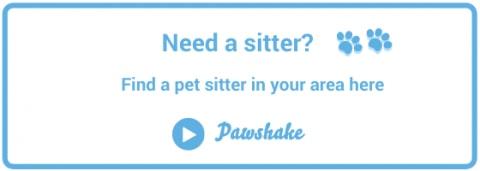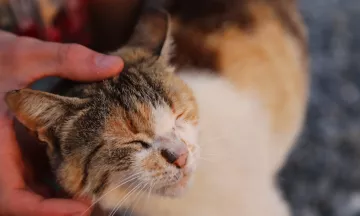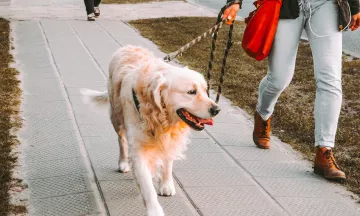Why is dog grooming important?
Dog grooming keeps your dog comfortable by managing their coat, as well as keeping their eyes, ears and teeth clean. Plus, an at-home grooming routine will make trips to the grooming salon less stressful and frequent. Last but not least, regular home grooming will spare your floor and furniture from excess fluff and doggy smells!
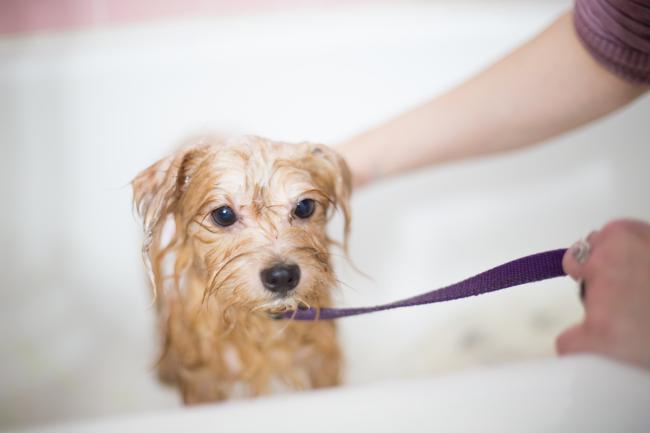
Here are seven DIY home dog grooming tips that will keep things smooth and stress-free for your pooch.
1) Get the right dog grooming tools
Speak with your vet or a professional dog groomer about your dog’s coat and breed. They will be able to suggest the right brush length and texture.
For example, dogs with thick fur (such as a golden retriever or border collie) may need a metal pin brush. Whereas dogs with short fur (such as a Jack Russell) may suit a shedding brush.
When it comes to grooming, don’t use human equipment such as toothbrushes, human shampoo, scissors and cotton buds. Instead, invest in dog-specific products.
And lastly, if you use clippers for nails or fur, make sure they are professional grade and kept in good condition. Throw out dull or rust clippers to avoid any accidents and keep the grooming process safe.
2) Create a relaxed environment for dog grooming
A dog can always pick up on our nervous energy, and grooming is no exception! As such, take your time and don’t rush the grooming process. Be confident and calm and your dog will be much more at ease.
Avoid cramming everything into one session, as this can be really overwhelming for a dog. Instead, break grooming up into smaller sessions. Starting small is a good way to get your dog used to their grooming routine.
Make a nice ritual for your dog by choosing a quiet location, such as your bathroom or a well-lit room in the house with a non-slip floor. And of course, use warm water and don’t let your dog get either too cold or hot.
Make grooming a positive experience by giving your dog plenty of gentle praise and a treat afterwards. Another method is to spread a little (natural and artificial sweetener-free) peanut butter on the inside of their food bowl. This way, they will be busy licking the bowl while you groom them.
3) Prioritize brushing
Regular brushing is the best way to keep your dog clean and your floor fluff-free. Furthermore, brushing your dog a few times a week will actually reduce the need to bathe them by removing a lot of dirt, grass and dead fur. Additionally, this will also ease them the experience of being handled, making them a lot more comfortable later with a professional dog groomer.
Notably, some breeds will need more regular brushing than others, whilst some might need more brushing during shedding season. Speak with your vet about your dog’s coat and how often you should brush them.
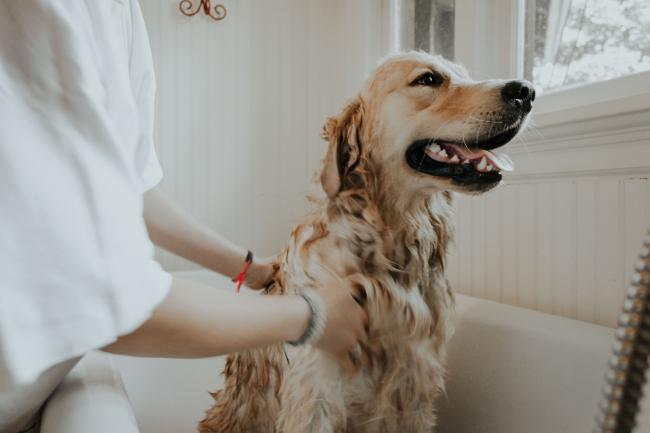
4) Bathe minimally
A dog’s skin and fur are protected by natural oils. These oils play a role in keeping their coat water-resistant, as well as in temperature regulation. As such, avoid stripping these oils by only washing your dog when they’re getting too smelly, or have rolled in something nasty at the park.
Be sure to give your dog a good brush before bathing them, as this will remove a lot of the dirt and make bathing easier.
Use a high-quality, unscented dog shampoo and dilute it a little. Doing so makes it a lot easier to rinse out after and leaves less residue behind.
The sound of a hairdryer can be quite frightening to a dog, so whip out a towel and dry them this way instead.
5) Ears, eyes and teeth
It’s super important to be gentle when cleaning your dog’s delicate ears, eyes and teeth.
Give your dog’s eyes a gentle wipe with a soft cloth every now and then to prevent gunk and tear stains. Some breeds may need their eyes wiped more often to avoid tear stains, such as Cavoodles and Labradoodles.
Avoid splashing water or using cotton buds on your dog’s ears, as this can cause damage or lead to infection. Instead, purchase ear cleaner specifically designed for dogs and follow the instructions.
Likewise, if you plan to give your dog’s teeth a clean, use doggy toothpaste and a dog toothbrush. There are plenty of teeth-cleaning treats and chew toys on the market, so shop around to find what best suits your pooch.
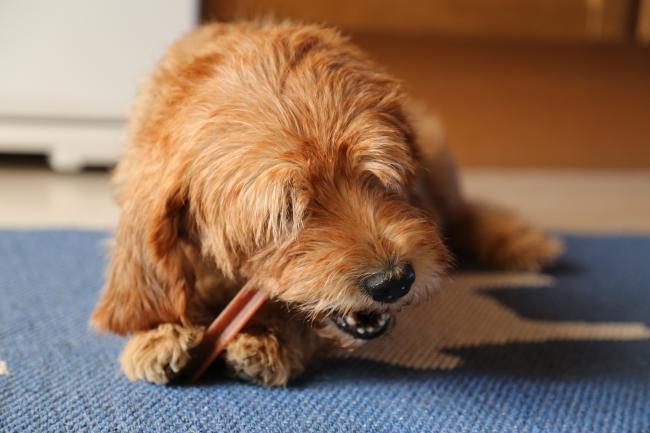
6) Be observant
Grooming is a great opportunity to get familiar with your dog’s skin and fur, so you can spot anything unusual. Give your dog a good check using your hands and eyes. Keep a lookout for irregularities on their skin or pests such as fleas.
If you notice any sore spots, lumps, smells or discharge from the skin, ears or eyes, give your vet a call. They can look closer and advise if your dog needs treatment.
7) Leave tricky bits to the dog grooming experts
Some grooming techniques, such as fur trimming, shaving and nail clipping, shouldn’t be tried at home without knowing exactly what you’re doing. The risk of injury is high, and you can unintentionally traumatise your dog, making it much harder for them to be handled in the future.
Instead, contact a professional dog groomer or enrol in a short dog grooming course to learn how to do these trickier techniques. Doing so will avoid injuring your dog and will give you the confidence to know you are doing it the right way.
If you can’t get to a groomer and your dog’s fur is getting out of control around its eyes, ears or paws, be very slow and careful. Only trim these areas when your dog is relaxed and lying down, and when their fur is dry. Only use the very tips of the clippers to avoid hurting your dog if they suddenly move. And, as we’ve said, preferably leave this step to the professionals.
Many of our pet sitters offer dog grooming services. Next time you make a booking with a pet sitter, ask if they can continue your dog’s usual grooming routine while you are away.


